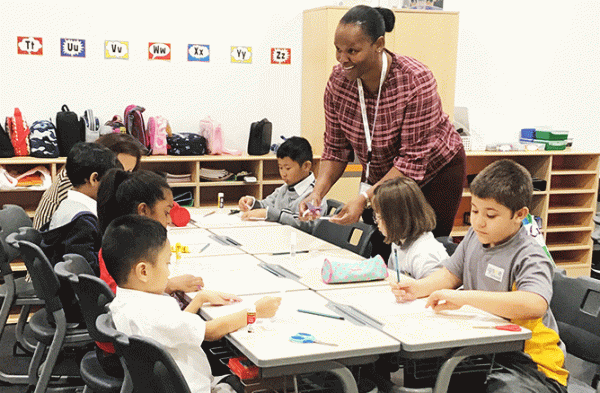
Teachers Guide: Strategies for Managing Classroom Behavior Effectively-Creating a positive classroom environment is essential for effective teaching and learning. However, managing student behavior can sometimes feel overwhelming. This Teachers Guide aims to provide practical strategies that can help educators foster a respectful, engaging, and productive classroom atmosphere. By implementing these techniques, teachers can minimize disruptions and maximize learning.
Understanding the Importance of Classroom Management

Effective classroom management sets the foundation for a successful learning experience. It helps maintain order, promotes positive interactions, and allows students to focus on their studies. When students feel safe and respected, they are more likely to participate actively and engage in the learning process.
Establishing Clear Expectations
One of the first steps in managing classroom behavior is establishing clear expectations. Here’s how to do it effectively:
Set Ground Rules Together
Involve students in creating classroom rules. This not only fosters a sense of ownership but also encourages students to understand the rationale behind the rules. Consider questions like:
- What behaviors promote a positive learning environment?
- How can we support each other in following these rules?
Communicate Expectations Clearly
Once the rules are established, communicate them clearly and frequently. Use simple language and visual aids to reinforce expectations. Regularly revisit these rules to remind students of their importance. (Read More: Minecraft Education and the Evolution of Game-Based Learning in Classrooms)
Building Strong Relationships
Strong teacher-student relationships are crucial for effective classroom management. When students feel connected to their teacher, they are more likely to respect authority and adhere to rules.
Get to Know Your Students
Take the time to learn about your students’ interests, backgrounds, and learning styles. This knowledge can help you tailor your approach to meet their individual needs and build rapport.
Show Empathy and Understanding
When addressing behavioral issues, approach the situation with empathy. Try to understand the underlying reasons for a student’s behavior. A compassionate approach can often de-escalate conflicts and encourage better behavior.
Implementing Positive Reinforcement
Positive reinforcement is a powerful tool for encouraging desired behaviors. Here are some effective strategies:
Use Praise and Rewards
Recognize and reward positive behavior with praise or small rewards. This could be verbal acknowledgment, stickers, or a class-wide reward system. Celebrating successes, no matter how small, can motivate students to continue exhibiting positive behavior.
Create a Behavior Tracking System
Implement a behavior tracking system where students can visually see their progress. This could include charts or digital tools where students can earn points for positive behavior, fostering a sense of accountability and motivation. (Read More: Super Teacher Worksheets: Revolutionizing Homework and In-Class Activities in 2024)
Developing Effective Consequences
Inevitably, there will be times when students don’t meet behavioral expectations. Having a fair and consistent system of consequences is essential.
Use Logical Consequences
Ensure that consequences are directly related to the behavior. For instance, if a student is disruptive during group work, a logical consequence might involve them completing the activity independently. This teaches responsibility and helps students understand the impact of their actions.
Maintain Consistency
Consistency is key in managing classroom behavior. Ensure that all students are treated fairly and that consequences are applied uniformly. This builds trust and reinforces the importance of the established rules.
Engaging Students in the Learning Process

Engaged students are less likely to exhibit disruptive behavior. Consider the following strategies to enhance engagement:
Incorporate Interactive Learning
Use interactive and hands-on activities to keep students interested. Incorporating group work, discussions, and technology can make lessons more dynamic and encourage active participation.
Provide Choices
Offering students choices in their learning can increase engagement. Allow them to select project topics or the format of their assignments. This sense of autonomy can lead to more responsible behavior.
Implementing Restorative Practices
Restorative practices focus on repairing relationships and building a positive classroom community. This approach can be beneficial in managing behavior. (Read More: How Minecraft Education is Revolutionizing Classroom Learning in 2024)
Facilitate Open Discussions
Create opportunities for students to discuss their feelings and resolve conflicts openly. Encouraging dialogue helps students develop empathy and understand different perspectives.
Use Peer Mediation
Train students in peer mediation techniques to help them resolve conflicts with their classmates. This not only empowers students but also fosters a collaborative and respectful environment.
Continuously Reflect and Adjust

Classroom management is an ongoing process. Regular reflection and adjustment of strategies are essential for success.
Seek Feedback
Regularly solicit feedback from students about the classroom environment and management strategies. This input can provide valuable insights and help you make necessary adjustments.
Attend Professional Development
Participate in workshops and training sessions focused on classroom management. Staying informed about new techniques and strategies can enhance your skills and effectiveness.
Conclusion article Teachers Guide: Strategies for Managing Classroom Behavior Effectively
Managing classroom behavior effectively is crucial for fostering a positive learning environment. By following this Teachers Guide, educators can implement strategies that promote respect, engagement, and collaboration. Remember that every classroom is unique, and flexibility is key. With patience and perseverance, you can create a thriving classroom where all students feel valued and motivated to learn.





3 thoughts on “Teachers Guide: Strategies for Managing Classroom Behavior Effectively in 2024”